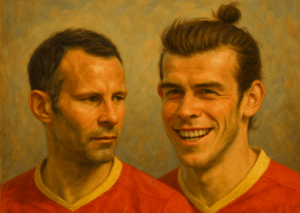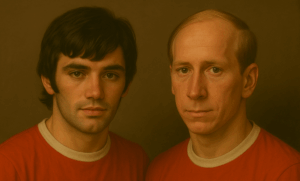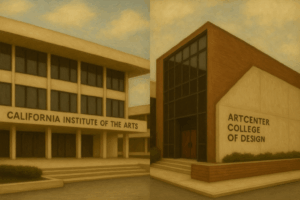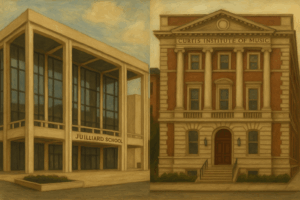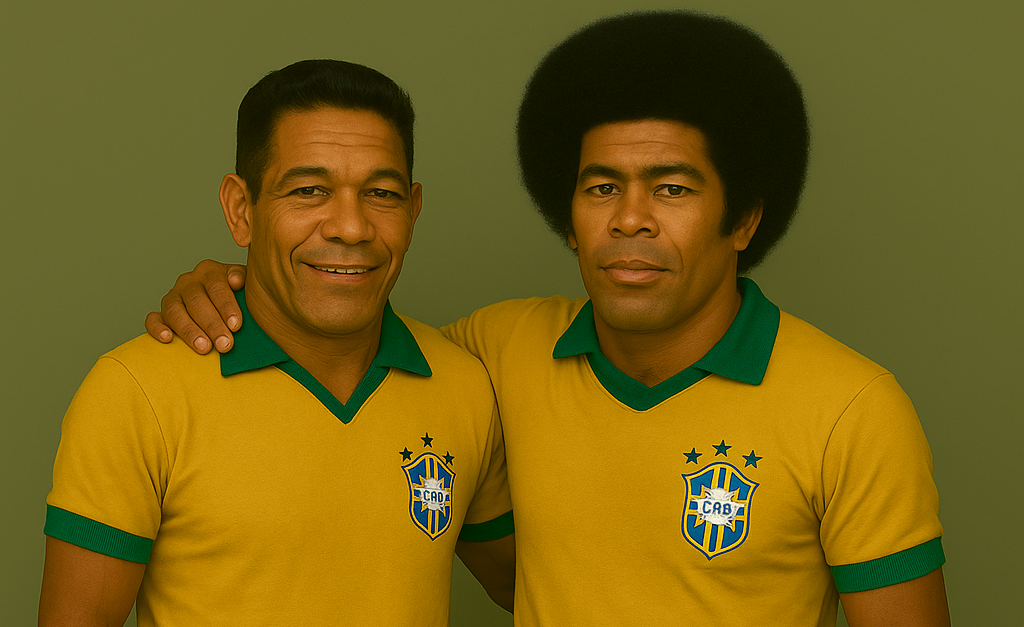
The GOAT of Brazil’s Right Wing?
In the history of football, few spaces are as mythical as Brazil’s right wing. And the two names that dominated that space, Garrincha and Jairzinho, remain icons symbolizing the very soul of Brazilian football, not just mere players. Their relationship is even more special. Garrincha was the untamed master of pure, artistic football, and Jairzinho was his successor who, idolizing him, inherited his position.
Garrincha was an artist who showed the essence of football through unpredictable dribbles and pure joy, as his nickname ‘Alegria do Povo’ (The People’s Joy) suggests. In contrast, Jairzinho was called ‘Furacão da Copa’ (The Hurricane of the Cup) and presented the image of a new era’s forward with overwhelming power, speed, and destructive finishing. This article, from a 2025 perspective, aims to delve into the essence of these two giants who reached greatness in different ways by conducting an in-depth analysis of their playing styles, careers, and the legacies they left behind.
1. Physique and Style: ‘The Angel with Bent Legs’ vs. ‘The Hurricane of the Cup’
Garrincha: The Genius Who Turned ‘Flaw’ into Art
Garrincha’s body seemed almost impossible for a footballer. He was born with a deformed spine, and his legs were of different lengths, with one being 6cm shorter than the other. Doctors diagnosed that it would be impossible for him to become a professional athlete.
However, in one of the greatest ironies in football history, it was precisely these physical ‘flaws’ that made Garrincha an unstoppable player. His bent legs created an abnormally low center of gravity and a unique step, which made it completely impossible for defenders to predict his movements.
His dribbling was not the product of structured training but was like a pure improvisation, and the crowds began to shout “Olé!” for the first time in football history in response to his play.
Jairzinho: The Destroyer of Power and Speed
Jairzinho had the opposite physical profile to Garrincha. Boasting a solid, muscular build, he was one of the best athletes of his time. His greatest weapons were his explosive acceleration, incredible speed, and overwhelming physique that allowed him to easily win physical battles against defenders.
His play was focused on direct, destructive breakthroughs rather than artistic dribbling like Garrincha’s. He combined the speed of a winger with the power and finishing ability of a striker. This was a prototype of the ‘wing-forward’ or ‘inside forward’ that would come to dominate modern football decades later.
2. Performance in the World Cup: Two Peaks That Wrote Myths
Garrincha: The Helper of 1958, The Absolute Ruler of 1962
- 1958 Sweden World Cup: In his first tournament alongside Pelé, he led Brazil to its first-ever championship with a brilliant performance that included two assists in the final.
- 1962 Chile World Cup: This tournament was entirely ‘Garrincha’s World Cup.’ When the ace Pelé was sidelined with an injury, he overcame immense pressure to become the team’s absolute leader, scoring multiple goals in both the quarter-finals and semi-finals to bring his country its second consecutive title. He became the first player in history to win the World Cup, the Golden Ball (MVP), and the Golden Boot (Top Scorer) in the same tournament.
Jairzinho: The Protagonist of a Perfect Tournament in 1970
Jairzinho’s World Cup legend was written at the 1970 Mexico World Cup. He achieved a feat unprecedented in football history: scoring in every single match of the World Cup finals. His performance, scoring a total of 7 goals in 6 matches, was the crowning achievement of the 1970 Brazil team, which is often considered the greatest team in football history.
World Cup Impact Comparison
| Category | Garrincha (1958 & 1962) | Jairzinho (1970) |
|---|---|---|
| Key Role | 1958: Key helper, 1962: Absolute ace | Main goalscorer of a perfect team |
| World Cup Wins | 2 (1958, 1962) | 1 (1970) |
| Major Individual Awards | 1962 Golden Ball (MVP), 1962 Golden Boot (Top Scorer) | 1970 Silver Boot (2nd Top Scorer) |
| Unique Feat | Led the team to victory after Pelé’s injury | The only player to score in every match of a World Cup |
3. Club Career: Inheriting the Glory of Botafogo
Garrincha: The Symbol of Botafogo, ‘The People’s Joy’
Garrincha played for Botafogo for 12 years, from 1953 to 1965, becoming the greatest icon in the club’s history. He became a living legend of the club, playing in nearly 600 matches and scoring over 230 goals.
Jairzinho: The Successor Who Emerged from His Idol’s Shadow
Jairzinho’s Botafogo career began under the shadow of his idol, Garrincha. When Garrincha left the team, he finally took over the right-wing position and began his own era, leading the team to a national league title in 1968. Later, in 1976, he reached the pinnacle of his club career by winning the Copa Libertadores, South America’s premier club competition, with Cruzeiro.
4. Records and Legacy: A Comparison in Numbers and Final Footprints
Statistical and Awards Comparison Analysis
| Category | Garrincha | Jairzinho |
|---|---|---|
| Main Clubs | Botafogo | Botafogo, Cruzeiro, Marseille |
| Club Career (Est.) | ~600 matches, 240+ goals | ~525 matches, 249 goals |
| Brazil National Team | 50 caps, 12 goals | 81 caps, 33 goals |
| World Cup Wins | 2 | 1 |
| Major Club Titles | 3 Campeonato Carioca | 1 Taça Brasil, 1 Copa Libertadores |
| Major Individual Awards | 1962 World Cup Golden Ball & Golden Boot | 1970 World Cup Silver Boot, 1970 World Cup All-Star Team |
| 20th Century Player Rankings | FIFA Player of the Century: 7th | World Soccer’s 100 Players of the 20th Century: 27th |
Posthumous Evaluation and Legacy
- Garrincha’s Legacy: The Incarnation of ‘Joga Bonito’
Garrincha is remembered as the incarnation of Brazilian football’s romantic ideal: ‘the beautiful game.’ He roamed the pitch with pure joy, improvisation, and artistry, unbound by tactical constraints. His unfortunate personal life and tragic end have only solidified his mythical status. - Jairzinho’s Legacy: The Great Forward of a Great Team
Jairzinho’s legacy is inextricably linked to the perfection of the 1970 World Cup and his unbreakable record. He is remembered as a symbol of power, efficiency, and victory. He was one of the most dominant and effective forwards of his time.
Conclusion: Icons of an Era, Eternal Legends
To make a final comparison between these two players is like choosing between two different faces of Brazilian football: the ‘heart’ and the ‘head.’
- Garrincha symbolizes the ‘heart’ of Brazilian football—passion, joy, artistry, and a beautiful struggle. He was ‘The People’s Joy,’ and his greatness is felt emotionally.
- In contrast, Jairzinho represents the ‘head’ of Brazilian football—tactical evolution, optimization of physical ability, and the ruthless execution of a winning formula. He was ‘The Hurricane of the Cup,’ and his greatness is understood logically and statistically.
In conclusion, they should be remembered not as rivals competing for a single crown, but as two complementary, eternal legends who together completed the brilliant duality of ‘Joga Bonito.’
